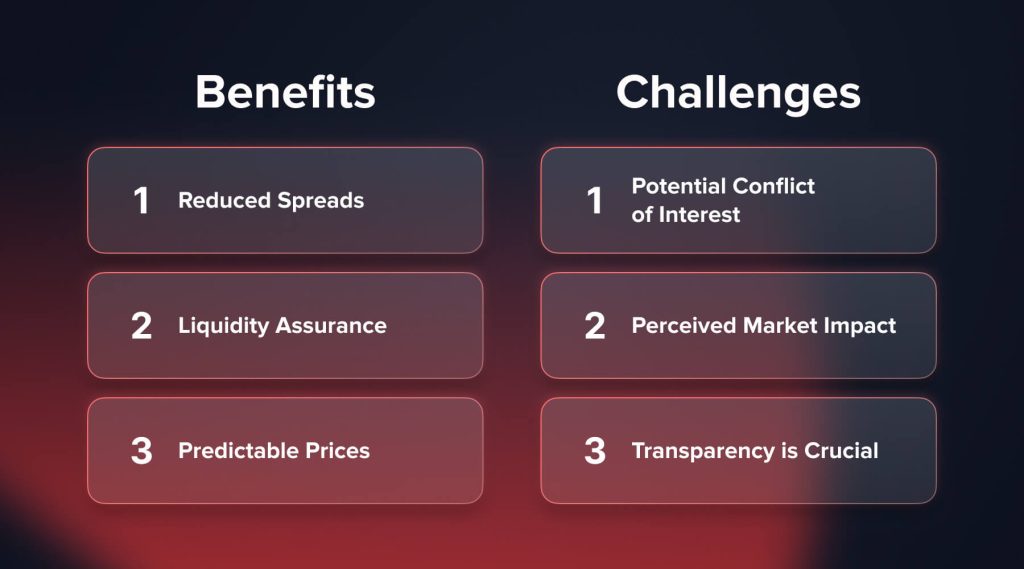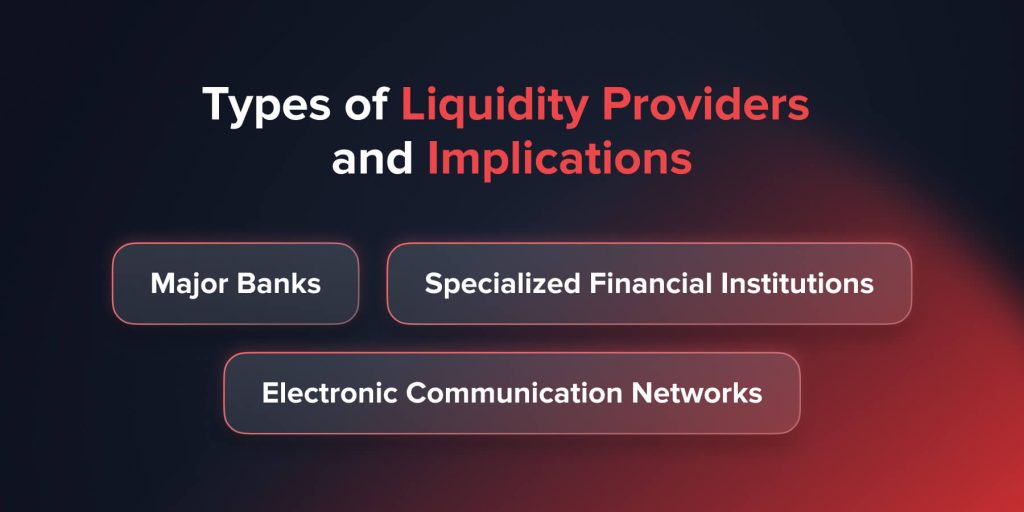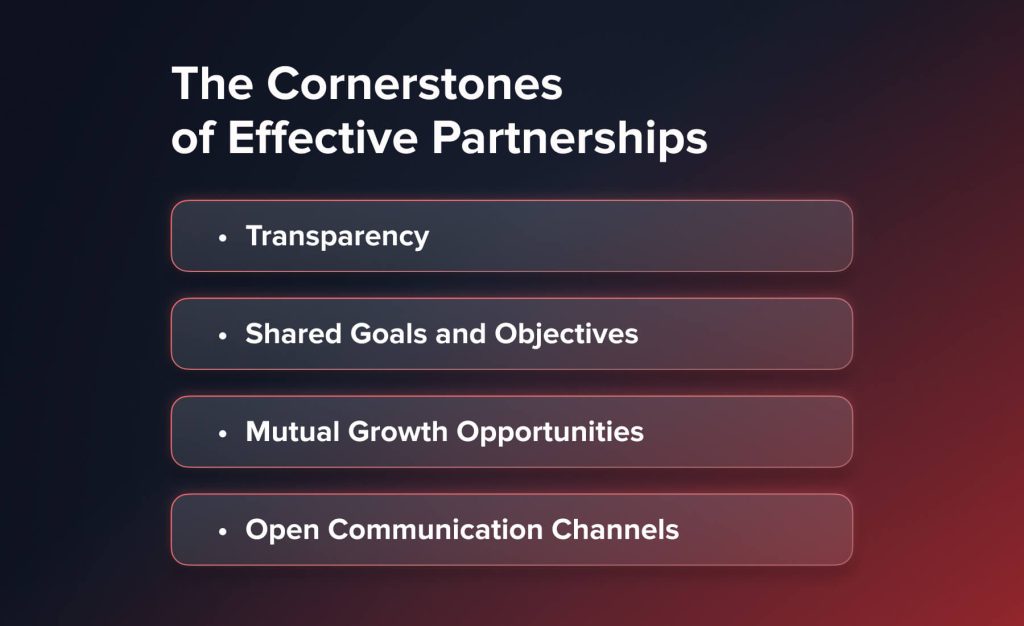
Маркет-мейкер и поставщик ликвидности: в чем разница?
В статье
Ликвидность по -прежнему является опорой для эффективной работы рынков в быстро меняющихся финансовых брокерах, основных игроках на этих рынках, зависят от тщательного знания компаний, которые поддерживают ликвидность: рыночные производители и Поставщики ликвидности . Recognizing their distinct rolesиstrategies, especially for brokerage owners, is pivotal in designing a compliantиscalable брокерская бизнес -модель . This article delves deep into these two pillars, highlighting their operations, advantages,иchallenges.
Понимание рыночных производителей
На финансовом рынке маркет -производители играют роли как покупки, так и продавцов. Их основная роль-обеспечить постоянную рыночную ликвидность, следовательно, соединение дисбаланса по запросу. Котируя ставку (купить) и попросить (продавать) цены для актива показывает свою готовность к торговле. Гарантируя, что активы постоянно доступны для торговли, независимо от более общих рыночных обстоятельств, они, таким образом, выполняют жизненно важную услугу.
Представьте себе сценарий, в котором не хватает продавцов для определенного актива. В такой ситуации трейдер, желающий приобрести, может найти сложно найти подходящего продавца. Здесь вмешивается производитель рынка, соглашаясь продать активы. С другой стороны, с недостаточным требованием, рыночный производитель рынка приобрел бы активы. Они следят за тем, чтобы у трейдеров всегда были коллеги для своей сделки, постоянно изменяя свои заявленные ставки и запасы в зависимости от динамики рынка.
Преимущества для брокеров и предприятий:

- Уменьшенные спреды:Разрыв между этими ценами - спредом - стремится быть меньше, чтобы производители рынка постоянно предлагают предложение и ставки. Особенно для обычных трейдеров более близкий спред может сделать торговлю более рентабельной.
- Обеспечение ликвидности:Производители рынка предоставляют сеть безопасности, гарантируя, что на другом конце всегда есть покупатель или продавец. Это особенно важно на меньших жидких рынках или во время высокой волатильности. Для брокерских компаний постоянная ликвидность является значительным преимуществом, обеспечивающим плавные операции и удовлетворенность клиентов, особенно в паре с надежными Брокер CRM Systems Это оптимизирует управление клиентами и маршрутизацию торговли.
- Предсказуемые цены:С постоянным присутствием рыночных, колебания цен, как правило, менее резкие. Постоянный поток предложений и цитат Ask может привести к более стабильным ценам, что полезно для трейдеров и, следовательно, брокерских компаний, с которыми они торгуют.
Проблемы и соображения:
- Потенциальный конфликт интересов:Поскольку производители рынка получают выгоду от распространения, они могут быть склонны манипулировать заявкой и спрашивать цены в своих интересах. Этот неотъемлемый конфликт интересов иногда может привести к тому, что трейдеры получат немного менее благоприятные цены.
- Воспринимаемое влияние на рынок:Существует мнение, что, поскольку производители рынка могут взять противоположную сторону торговли, они могут повлиять на цены на активы. Хотя их основная роль заключается в том, чтобы обеспечить ликвидность, крупные рыночные производители рынка из -за своего огромного объема могут оказать заметное влияние на направление рынка.
- Прозрачность имеет решающее значение:Для брокеров работа с рыночными производителями требует прозрачности. Любые возможные конфликты, представляющие интерес, должны быть раскрыты, и клиенты должны быть рекомендованы, если основным источником ликвидности брокера является производитель рынка. Открытый канал связи гарантирует, что доверие остается нетронутым.
Понимание поставщиков ликвидности
Основой эффективной торговли на финансовых рынках являются поставщики ликвидности или LPS. В отличие от рыночных производителей, которые активно строят рынок, цитируя как покупку, так и продажу цены, поставщики ликвидности обычно обеспечивают стоимость активов в зависимости от состояния рынка. Их главная цель - обеспечить рынок более сложность, чтобы можно было выполнить большие заказы без значительного влияния на ценности активов.
LP, в силу их обширных финансовых резервов, могут обрабатывать значительные транзакции, которые в противном случае могли бы дестабилизировать небольшие рынки. Трейдеры используют ликвидность, которую эти компании предоставляют для завершения крупных транзакций, поэтому гарантируя минимальное проскальзывание и эффективное выполнение заказа. Это симбиотическая связь: торговцы получают от глубины; Поставщики увеличения ликвидности от объема торговли, особенно в высокочастотных Алгоритмическая торговля среда.
You may also like

Типы поставщиков ликвидности и последствия:

- Основные банки:Среди крупнейших банков в мире, включая Citibank, Goldman Sachs и JPMorgan, некоторые работают в качестве основных поставщиков ликвидности. Многие брокеры выбирают их из -за их большой ликвидности, учитывая их большие финансовые ресурсы. Тем не менее, их масштаб может иногда означать меньшую гибкость в переговорах по контракту.
- Специализированные финансовые учреждения:Это фирмы, специально разработанные, чтобы предложить рыночную ликвидность. Хотя они могут не соответствовать масштабам крупных банков, они могут предоставить более специализированные или нишевые предложения, обслуживая конкретные сегменты рынка.
- Электронные сети связи (ECNS):Выступая в качестве поставщика виртуальной ликвидности, эти автоматизированные алгоритмы совпадают за покупку и продажу заказы на активы. С Ecns Покажите лучшую доступную ставку и спросите цены у многих игроков рынка, они могут обеспечить более открытые цены.
Преимущества для бизнес -операций:
- Конкурентные спреды:Сотрудничество с несколькими LPS позволяет брокерам делать покупки по лучшим ценам, обеспечивая более жесткие спреды для их клиентов. Это особенно полезно для брокеров, обслуживающих высокочастотные трейдеры, где даже незначительное повышение цен может значительно повлиять на прибыльность.
- Оптимальное выполнение торговли:Благодаря более глубоким пулам ликвидности крупные заказы получают более эффективные результаты, минимизируя неблагоприятное воздействие на цены на активы. Это гарантирует, что даже институциональные клиенты или те, которые торгуют в больших объемах, испытывают минимальное проскальзывание.
- Диверсификация рисков:Взаимодействие с различными LPS помогает брокерам диверсифицировать их оперативный риск. В маловероятном случае проблем с LP, наличие нескольких поставщиков гарантирует, что торговля может продолжаться беспрепятственно.
- Привлечение более широкой клиентской базы:Потенциальные клиенты найдут большую привлекательность в хорошо организованном пуле ликвидности с конкурентными ценами и эффективным выполнением заказа, что является ключевой функцией для предложений брокеров Управляемые торговые счета для людей с высокой сетью или учреждениями. Это показывает, насколько посвященным брокерским сроком, чтобы обеспечить максимально возможный опыт торговли.
Ключевые различия между рыночными и поставщиками ликвидности
Миры рыночных производителей и поставщиков ликвидности часто пересекаются, но они работают с различными механизмами и целями. Для владельцев брокерских услуг и руководителей бизнеса проницательность их различий жизненно важно для стратегического выравнивания и эффективных операций.
Операционная динамика:
- Рыночные производители
Они активно участвуют в рынке. По самой своей природе производители рынка преднамеренно производят двухсторонний рынок. Они гарантируют, что независимо от рыночных обстоятельств, всегда есть контрагент, готовый к трейдерам, цитируя цены на покупку и продажу для конкретного товара. Их операционная модель вращается вокруг облегчения непрерывной торговли даже в менее ликвидных активах или во время рыночного стресса.
- Поставщики ликвидности
Их роль более пассивная. Вместо того, чтобы диктовать цены, LPS предлагает активы на основе текущих рыночных ставок. Они улучшают глубину рынка, обеспечивая выполнение сделок без существенных сменов цен, что особенно важно для значительных сделок. Они сосредоточены на заполнении заказов, а не на определении цены.
Влияние на цены и исполнение активов:
- Рыночные производители
Их влияние может привести к более предсказуемому ценам, что особенно полезно на рынках, где ликвидность является спорадической. Двойная цитата гарантирует, что спреды остаются более узкими, обеспечивая более стабильную торговую среду. Однако иногда это может означать, что трейдеры не всегда могут получать наиболее благоприятные цены, особенно если производитель рынка является доминирующей организацией в определенном классе активов.
- Поставщики ликвидности
На рынках со многими поставщиками ликвидности конкуренция вызывает более выгодные цены для трейдеров. Их глубина гарантирует, что даже большие сделки могут быть выполнены с минимальным воздействием цен. Это особенно выгодно на высококфонах, где огромный объем торговли и наличие нескольких LPS может привести к очень конкурентным спредам.
Управление рисками для брокеров:
- Рыночные производители
Вовлечение в первую очередь с одним или ограниченным рыночным производителем может представить конкретный риск контрагента. Если производитель рынка пренебрегает своими обязанностями или сталкивается с финансовыми проблемами, торговля окружающей средой может быть нарушена. Для брокеров крайне важно оценить финансовое положение и репутацию выбранных рыночных производителей.
- Поставщики ликвидности
Диверсификация по нескольким LPS может значительно снизить риски. Если один LP сталкивается с проблемами, наличие альтернативных поставщиков гарантирует, что выполнение торговли остается незатронутым. Более того, с несколькими организациями, борющимися за бизнес, брокерские компании часто могут договариваться о лучших условиях и ценах.
Требования к капиталу и приверженность:
- Рыночные производители
Они обычно нуждаются в существенных резервах капитала. Учитывая их роль в активном цитировании как покупки, так и продаже цен, рыночные производители часто поддерживают значительный капитал для управления рисками, связанными с задержанием, особенно в изменчивых рыночных ситуациях.
- Поставщики ликвидности
LPS не обязательно требует такой же глубины капитальных резервов, что и рыночные. Их основная функция - облегчение сделок, что часто означает, что они более часто компенсируются позициями и могут не удерживать их в течение длительных периодов.
Роль в стабильности рынка:
- Рыночные производители
Стремясь покупать и продавать активы, они часто выступают в качестве стабилизирующей силы, особенно на нишевых или менее жидких рынках. Их непрерывное присутствие может предотвратить резкие пробелы на рынке и обеспечить чувство надежности другим участникам рынка.
- Поставщики ликвидности
Хотя они также способствуют стабильности рынка, их воздействие часто более выражено на широко распространенных жидких рынках. Предлагая глубину, они обеспечивают плавную торговую казнь даже во время торговли большим объемом.
Природа отношений с брокерами:
- Рыночные производители
Отношения часто более структурированы. Брокерские компании могут иметь конкретные соглашения, в которых подробно описываются цены, объемы и условия взаимодействия, обеспечивая предсказуемый поток сделок.
- Поставщики ликвидности
Взаимодействия имеют тенденцию быть более плавными. Несмотря на то, что могут быть всеобъемлющие соглашения, повседневные взаимодействия обусловлены динамикой рынка, с ценами, объемами и спредами, постоянно корректирующимися на основе условий в реальном времени.
Технологические интерфейсы и интеграция:
- Рыночные производители
Учитывая их активную роль в ценах, они часто имеют сложные технологические интерфейсы, позволяющие общаться в реальном времени и спрашивать цены. Интеграция с брокерами может потребовать адаптированных технических решений для обеспечения плавного потока данных.
- Поставщики ликвидности
Их системы предназначены для скорости и объема. Акцент делается на эффективную обработку многих торговых запросов, часто из нескольких брокеров одновременно. Интеграция, как правило, более простая, подчеркивая быстрое выполнение заказа.
Чтобы упростить эти различия, вот бок о бок сравнение того, как производители рынка и поставщики ликвидности работают в ключевых измерениях
| Атрибут | Рынок | Поставщик ликвидности |
| Торговый подход | Активно поддерживать как покупать, так и продавать цены | Установить глубину рынка, предлагая рыночные ставки в реальном времени |
| Ценовое влияние | Стабилизировать цены на рынках, не имея ликвидности | Конкурировать, чтобы обеспечить более жесткие спреды своим пользователям |
| Требования к капиталу | Требовать значительного капитала для поддержания запасов и риска. | Требовать умеренного капитала для эффективного завершения сделок |
| Риск исполнения | Централизованное, более высокое воздействие контрагента | Децентрализованный, распространяющийся по нескольким провайдерам |
| Технологическая интеграция | Подключите сложные системы API для потоковых кавычек | Системы высокоскоростного выполнения включает обработку громкости |
| Роль стабильности рынка | Стабилизируется во время волатильности или низкой ликвидности | Оптимизирует выполнение во время пиковых объемов |
| Брокерские отношения | Структурированные соглашения с конкретными условиями | Динамические, управляемые громкостью взаимодействия |
Брокерские компании, которые понимают эти различия, могут соответствовать их моделям выполнения с подходящими партнерами для повышения производительности и удовлетворенности клиентов.
Нормативный ландшафт и соответствие
Финансовый сектор сильно зависит от законов и мер по соблюдению требований. Следуя этим руководящим принципам помогает брокерам сохранять доверие и гарантировать бесшовную работу финансовой экосистемы, когда они работают с рыночными и поставщиками ликвидности.
Брокерские компании работают в среде, где доверие больше всего управляет. Будь то институциональные компании или отдельные торговцы, клиенты, которые вкладывают свои деньги в брокерские услуги, хотят гарантии того, что их инвестиции безопасны и что брокер ведет справедливый и открытый бизнес. Сильная соблюдение нормативных правил помогает развивать и укрепить эту уверенность.
Политики, касающиеся брокеров и их взаимодействия с рыночными и поставщиками ликвидности, варьируются в зависимости от страны и области. Например:
- В Европе Европейское управление по ценным бумагам и рынкам (ESMA) имеет конкретные стандарты, которые регулируют контракты на различия (CFD) и их взаимодействие с рыночными производителями.
- Для США, особенно в отношении прозрачности и справедливых цен, Комиссия по ценным бумагам и биржам (SEC) и Комиссии по торговле товарными фьючерсами (CFTC) устанавливают правила.
- С конкретными критериями соответствия в Азиатско-Тихоокеанских странах, таких как Сингапур и Гонконг свои собственные регулирующие органы: Комиссия по ценным бумагам и фьючерсам (SFC) и Монетарная власть Сингапура (MAS).
Навигация по регулирующему лабиринту:
Учитывая разнообразие регулирующих органов и их руководящие принципы, брокерские компании должны:
- Оставайся в курсе:Регулярно обновляются о любых нормативных изменениях, в основном, если они работают в нескольких юрисдикциях. Крайне важно иметь специальную команду по соблюдению или консультант, знакомый с местными правилами.
- Обеспечить прозрачность:Брокерские компании должны вести точные записи всех транзакций, особенно тех, кто участвует в рыночных производителях и поставщиках ликвидности. Эти записи должны быть легко доступны для аудитов или регулирующих проверок.
- Построить отношения:Наличие открытых каналов связи с регуляторами может быть неоценимым. Внедрение регулярных диалогов, посещение отраслевых семинаров или участие в консультационных раундах может дать брокерским компаниям более четкий взгляд на нормативные ожидания и новые тенденции.
Знание регулирующей сцены - это не просто избегание штрафов; Это также стратегическая потребность для владельцев брокерских услуг. Гармонизируя операции с правилами, позиция брокерских услуг может улучшиться, и будут привлечены более избирательные клиенты и партнеры. Это может также избежать дорогостоящих перерывов, вызванных юридическими нарушениями.
Ключевые выводы
- Производители рынка активно создают и обеспечивают ликвидность с ценами на покупку и продажи, тогда как поставщики ликвидности обеспечивают глубину и позволяют более крупные транзакции без заметно влияя на цены на активы.
- Поставщики ликвидности обеспечивают конкурентоспособные цены на ликвидных рынках, рыночные производители гарантируют постоянную торговлю со стабильными ценами.
- В то время как производители рынка активно помогают определять цены, поставщики ликвидности пассивно реагируют на текущие рыночные условия.
Создание эффективных партнерских отношений и сотрудничества
Ниды в запутанной ткани финансовой экосистемы, партнерских отношений и альянсов связывают учреждения, чтобы увеличить свою комбинированную мощь и охват. Будь то с производителями рынка или поставщиками ликвидности, эти отношения являются стратегическими партнерскими отношениями, которые могут определить будущий успех брокера.
Краеугольные камни эффективного партнерства:

- Прозрачность:Прозрачность является основой любого солидного партнерства в финансовом мире. Обе стороны должны иметь четкую видимость в условиях партнерства, операционных процессов и любых потенциальных проблем. Инструменты, такие как общие мониторные достоинства или регулярные отчеты о производительности, могут способствовать прозрачности, обеспечивая выравнивание обеих сторон.
- Общие цели и задачи:Партнерство требует согласования интересов, если оно будет процветать. Это подразумевает, что обе стороны имеют одинаковые цели и видение того, куда они хотят, чтобы сотрудничество продолжалось. Это выравнивание можно способствовать с помощью регулярных стратегических сессий и открытых диалогов о рыночных тенденциях, проблемах и возможностях.
- Возможности взаимного роста:Работа вместе не должна быть игрой с нулевой суммой. Идеальное сотрудничество - это те, в которых расширение для одной стороны приводит к расширению для другой. Для брокеров это может означать доступ к лучшей ликвидности или более выгодным терминам. Для производителей рынка или поставщиков ликвидности это может привести к более широкой клиентской базе или увеличению объемов торговли, особенно при интеграции с белые брокерские платформы Это обеспечивает быстрое масштабирование.
- Открытые каналы связи:Финансовый ландшафт динамичен, с рыночными условиями и регулирующими руководящими принципами постоянно развиваются. Следовательно, важно поддерживать открытые каналы общения. Регулярные проверки, сеансы обратной связи и совместные учебные программы могут гарантировать, что обе стороны находятся на одной странице и могут быстро адаптироваться к изменяющимся сценариям.
Для брокеров, рассматривающих долгосрочное развитие и стабильность, стратегическое сотрудничество с рыночными или поставщиками ликвидности может оказаться преобразующим. Эти отношения, тем не менее, не должны рассматриваться как фиксированные. Это динамические сущности, которые необходимо повысить, оценивать и усовершенствовать, чтобы убедиться, что они остаются взаимовыгодными в постоянно меняющейся финансовой среде. Брокерские компании могут максимизировать фактические возможности этих партнерских отношений, подчеркивая открытость, совместное развитие и постоянную оценку, следовательно, приведя их к постоянному успеху.
Заключение
Современные брокеры должны договориться о сложных мирах рыночных и поставщиков ликвидности. Брокерские компании могут сделать образованный выбор, зная их обязанности, выгоды и возможные риски, поэтому гарантируя устойчивое развитие и укрепляя доверие клиентов в постоянном изменении финансовой сцены.
Глоссарий ключевых терминов
Bid-Ask Spress
Это означает разницу между тем, что покупатели хотят заплатить (цена предложения), и тем, какие продавцы требуют (спросите цену). Меньшее или более плотное распространение часто ассоциируется с ликвидным рынком и более низкой стоимостью торговли.
Проскальзывание
Разница между тем, что вы можете купить или продать актив. Распространено во время высокой волатильности или низкой ликвидности.
A-книга
Брокерская модель, в которой клиентские заказы направляются непосредственно для внешних поставщиков ликвидности. Брокер извлекает выгоду от спредов или комиссий, не привлекая к риску его/ее собственного капитала.
B-книга
Модель, в которой брокер выполняет сделки через свой собственный капитал, эффективно торговая с клиентами. Обычно в сочетании с стратегиями рынка.
FAQ
Производитель рынка цитирует и продает цены в любое время, покупая, когда вы хотите продавать и продавать, когда другие хотят купить, обеспечивая непрерывную торговлю и более жесткие спреды. Напротив, поставщик ликвидности пассивно обеспечивает глубину рынка в виде постоянных потоков цен, которые отражают спрос в реальном времени и не конкурируют с покупателем или продавцом; Вместо этого они предоставляют услугу выполнения заказа (т. Е. Установка цен).
Да. Некоторые крупные игроки также становятся производителями рынка и поставщиками ликвидности, особенно в условиях торговли с несколькими активами или гибридами брокерских моделей. Последний поддерживает более высокую ликвидность выполнения и позволяет им контролировать спреды.
Он основан на бизнес -модели брокера. Вот почему брокеры B-книги могут хотеть работать с рыночными производителями, чтобы сохранить сделки внутренней и попытаться управлять спредами. Использование A-книги позволяет вам подключаться ко многим LPS, что снова позволяет создавать более плотные спреды, меньше проскальзывания и лучшего качества выполнения. В действительности, большинство брокеров используют смесь двух, чтобы иметь баланс между риском и производительностью.
Да, особенно поставщики ликвидности 1 уровня. Нормативный надзор варьируется в зависимости от региона: ESMA в ЕС; CFTC и SEC в США; FCA в Великобритании; Мас в Сингапуре; SFC в Гонконге. Брокеры, работающие с LPS, должны обеспечить, чтобы эти партнеры соответствовали соответствующим стандартам соответствия и прозрачности.
Обновлено:
8 августа 2025 г.



